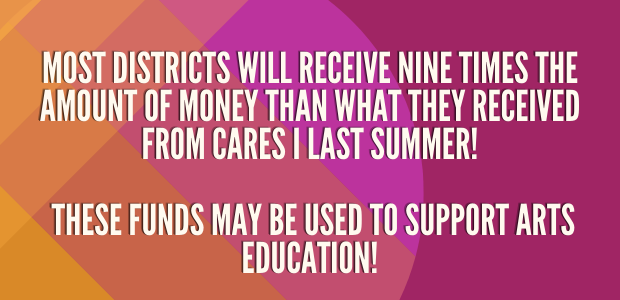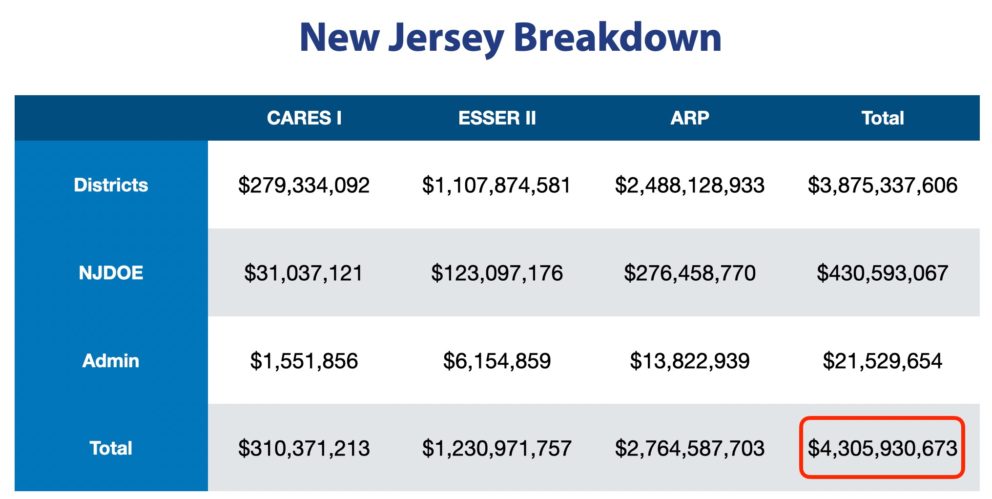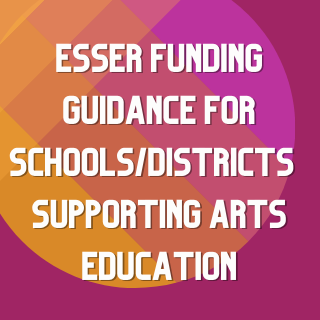
Updated May 26, 2021
The American Rescue Plan (ARP) was signed into law on March 11, 2021. This new COVID relief bill extends or modifies several provisions in the Coronavirus Aid, Relief and Economic Security Act (CARES I) that was passed in March 2020 and the Coronavirus Response and Relief Supplemental Appropriations Act (CARES II) was signed into law on Dec. 27, 2020 with significantly more money. This brings the total authorizations to stabilize public education to $281 Billion.

The new relief bill authorizes $168 billion for the Education Stabilization Fund. The bulk of that funding ($126 Billion) falls under Elementary and Secondary School Emergency Relief (ESSER III).
For this document we will refer to this generically as ESSER III Funding. ESSER III will receive an additional $126 billion on top of the ESSER II funding of $54 billion and the $13 billion that was allocated under ESSER I last year. For New Jersey the funding breakdown looks like this:

With additional help on the way, now is the time to plan with school administrators about how this funding can support arts education. Reach out to your building principal to discuss the resources that are necessary to conduct arts classes safely in-person. The principal will either have spending authority on the funds or will be able to help submit a request for arts-related purchases at the district level.
Additionally, 20% of ESSER III Funding going to districts must be used to support “learning loss” as well as social emotional learning.
Arts Education and ESSER Webinar
To view the Arts Ed NJ ESSER Webinar go here and use the passcode: a101&ser
You may download the presentation slide here
To download a PDF of this information go here
Sample Letter for Principal/Supervisor/Administration

Allowable Use of FundThere are sixteen (16) numbered categories of allowable use from the state (see the list below). Be prepared to suggest some ways these funds may be used to support arts education. The following includes several ideas and the related category number for each.
Click + to reveal details
- Individual instruments for each student to eliminate sharing (3,5)
- Individual mouthpieces for each student (3,5)
- Rental programs so that each student will have their own instrument (3,5)
- Props, Scenery, staging (3,5)
- Dance Classroom Furniture (cubbies, bins, shelves, etc) to support distancing of student belongings and instructional materials (13)
- Individual dance shoes and somatic materials (yoga mat, yoga blocks, theraband, etc) for each student (3,5)
- Make-up kits for each performer
- Appropriate cleaning and sanitizing materials (7)
- Sonic instrument cleaners
- Mouthpiece cleaner
- Ensuring Health and Safety (3,5)
- Additional instruments/mouthpieces so students are not required to share
- Addressing the recommendations of the NFHS research studies
- Performer masks
- Choral masks
- Additional masks for when students’ masks are overly saturated
- Instrument masks and bell covers
- Appropriate airflow upgrades in arts classrooms (13,14)
- Headsets and amplifiers for educators and others
- Plastic Brackets
- Ear Guards
- Supplies to sanitize and clean facilities (7)
- Hand sanitizer
- Disinfectant wipes
- Disinfectant spray
- Dance floor cleaner appropriate for marley, wood floor or other dance floor surfaces
- Microphone Cleaner
- Appropriate airflow upgrades in arts classrooms including ventilation improvements with a special focus on rooms without windows (13,14)
- Ensure proper ventilation for all arts classrooms (13,14)
- Supplies and materials to make instructional environment meet recommended standards (barrier tape, portable carts, tents/pop-up canopies for outdoor instruction, platforms/portable stages, pipes & drapes, folding chairs/folding tables related materials) (15)
- Temperature checks/screening for audience members attending in person productions
- Signage
- Equipment required to accommodate social distancing (12)
- Addressing the recommendations of the NFHS Research Studies (13, 14, 15)
Note: Auditoriums present unique air quality concerns because of their intermittent occupancy. Also many inside school auditoriums do not have windows that can open to allow for air flow. In order to get back to having indoor productions with live audience members, upgrades to school auditorium air filtration systems and or HVAC filters need to become a priority. This will in turn create clearer air and reduce the risk of introducing and transmitting SARS-CoV-2. Portable room air cleaners can also be helpful to provide indoor air cleaning to smaller backstage areas.
- Tools and resources for distance education/learning (9)
- Trainings in available online resources specifically designed for arts educators to create virtual ensemble performances/productions/exhibitions
- Software programs to assist students with guided practice and self-assessment while learning how to play their instruments in a virtual learning environment
- Software programs to assist students with arts learning
- Software programs for video editing and music editing
- Music licensing for virtual productions
- Online memberships to virtual libraries, streaming platforms, and virtual performances/field trips
- Supporting low-income students with resources to help them with online learning (4,9)
- Instruments for every child
- Instrument supplies such as reeds, rosin, trumpet grease, etc.
- Visual art kits
- Dance shoes for every child
- Choreography Supply Kit
- Online private or group lessons with master teaching artists in partnership with local arts organizations
- Embed Social Emotional Learning into arts education curriculum and lesson plans. (10)
- Provide tutoring programs outside normal school hours to address student needs. (11)
- Group instruction in various arts disciplines
- Fund out of school time arts training programs with local arts organizations
- Activities to address the unique needs of low-income children or students, children with disabilities, English Language Learners, racial and ethnic minorities, students experiencing homelessness, and foster care youth, including how outreach and services delivery will meet the needs of each population (4)
- Development of a peer coaching program
- Establishment of partnerships with local Latin Chambers of Commerce, United Sound, etc.
- Establishment of partnerships with local, regional, and/or statewide arts, culture, and historic organizations to utilize current or develop programming
- Provide internet access for students struggling to learn remotely (9)
- Provide additional staffing to expand beginner programs to reach students who were unable to participate in arts instruction during the 20/21 school year
- Offer career and technical education services to prepare all students for postsecondary education and the workforce (e.g., virtual job-shadowing, resume writing, interview skills, etc.)
- Provide extra supports aligned to the district’s regular education program, which may include services to assist preschool children in the transition from early childhood education programs to elementary school programs (also, the transition from elementary to middle school and middle school to high school)
- Provide basic instruction on trouble-shooting and the maintenance of technology, connectivity, file-sharing, remote tech support, etc.
- Planning and implementing activities related to summer learning and supplemental afterschool programs, including providing classroom instruction or online learning during the summer months and addressing the needs of low-income students, students with disabilities, English Language Learners, migrant students, students experiencing homelessness, and children in foster care. (11,12)
- Enrichment activities including those relating to dance, music, theatre and visual art (music example: guitar, keyboard, mariachi, music technology, ukulele, melodica, drum circles, steel drum band etc. dance examples: choreography; wellness – yoga, pilates, mindfulness, floor barre; dance for camera; movement practices not covered in the curriculum; dance production; etc.)
- Delivery of services during extended school year programs and/or summer enrichment programs for all students (11)
- Band, Music, Theatre, Dance, Visual Art camps
- Parks and Rec programs
- Big Brother, Big Sister programs
- School district summer enrichment programs
- Fund in-district summer arts programs/Saturday programs
- Deliver extension activities outside normal school hours to support a successful return to school (11)
- Introduction to music, dance theatre and/or visual art induction programs prior to the opening of school
- Fund arts enrichment summer camps and pre-professional summer training programs
- Supplement tuition for out-of-district pre-college summer programs
- Fund student internships with local arts organizations/companies
- Create CTE summer bridge program for students who are transitioning from Middle School to High School (11)
- Developing and implementing plans for the next school year. (1,2,5, 8)
- Professional development time to plan for return to school
- Professional development time to plan and coordinate performances



(1) Any activity authorized by the ESEA of 1965, including the Native Hawaiian Education Act and the Alaska Native Educational Equity, Support, and Assistance Act (20 U.S.C. 6301 et seq.), the Individuals with Disabilities Education Act (20 U.S.C. 1400 et seq.) (‘‘IDEA’’), the Adult Education and Family Literacy Act (20 U.S.C. 1400 et seq.), the Carl D. Perkins Career and Technical Education Act of 2006 (20 U.S.C. 2301 et seq.) (‘‘the Perkins Act’’), or subtitle B of title VII of the McKinney-Vento Homeless Assistance Act (42 U.S.C. 11431 et seq.).
(2) Coordination of preparedness and response efforts of local educational agencies with State, local, Tribal, and territorial public health departments, and other relevant agencies, to improve coordinated responses among such entities to prevent, prepare for, and respond to coronavirus.
(3) Providing principals and other school leaders with the resources necessary to address the needs of their individual schools.
(4) Activities to address the unique needs of low-income children or students, children with disabilities, English learners, racial and ethnic minorities, students experiencing homelessness, and foster care youth, including how outreach and service delivery will meet the needs of each population.
(5) Developing and implementing procedures and systems to improve the preparedness and response efforts of local educational agencies.
(6) Training and professional development for staff of the local educational agency on sanitation and minimizing the spread of infectious diseases.
(7) Purchasing supplies to sanitize and clean the facilities of a local educational agency, including buildings operated by such agency.
(8) Planning for, coordinating, and implementing activities during long-term closures, including providing meals to eligible students, providing technology for online learning to all students, pro- viding guidance for carrying out requirements under the IDEA and ensuring other educational services can continue to be provided consistent with all Federal, State, and local requirements.
(9) Purchasing educational technology (including hardware, software, and connectivity) for students who are served by the local educational agency that aids in regular and substantive educational interaction between students and their classroom instructors, including low-income students and children with disabilities, which may include assistive technology or adaptive equipment.
(10) Providing mental health services and supports.
(11) Planning and implementing activities related to summer learning and supplemental after-school programs, including providing classroom instruction or online learning during the summer months and addressing the needs of low-income students, children with disabilities, English learners, migrant students, students experiencing homeless-ness, and children in foster care.
(12) Addressing learning loss among students, including low-income students, children with disabilities, English learners, racial and ethnic minorities, students experiencing homelessness, and children and youth in foster care, of the local educational agency, including by—
(A) Administering and using high-quality assessments that are valid and reliable, to accurately assess students’ academic progress and assist educators in meeting students’ academic needs, including through differentiating instruction.
(B) Implementing evidence-based activities to meet the comprehensive needs of students.
(C) Providing information and assistance to parents and families on how they can effectively support students, including in a distance learning environment.
(D) Tracking student attendance and improving student engagement in distance education.
(13) School facility repairs and improvements to enable operation of schools to reduce risk of virus transmission and exposure to environmental health hazards, and to support student health needs.
(14) Inspection, testing, maintenance, repair, replacement, and upgrade projects to improve the in- door air quality in school facilities, including mechanical and non-mechanical heating, ventilation, and air conditioning systems, filtering, purification and other air cleaning, fans, control systems, and window and door repair and replacement.
(15) Other activities that are necessary to maintain the operation of and continuity of services in local educational agencies and continuing to employ existing staff of the local educational agency.
(16) Develop strategies and implement public health protocols including, to the greatest extent practicable, policies in line with guidance from the CDC for the reopening and operation of school facilities to effectively maintain the health and safety of students, educators, and other staff.

Click + to reveal details

